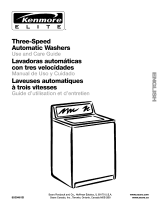2
■ Install or store where it will not be exposed
to temperatures below freezing or exposed
to the weather.
■ Properly ground washer to conform with all
governing codes and ordinances. Follow details
in Installation Instructions.
IMPORTANT SAFETY INFORMATION.
READ ALL INSTRUCTIONS BEFORE USING.
WARNING!
For your safety, the information in this manual must be followed to minimize the risk of fire
or explosion, electric shock, or to prevent property damage, personal injury, or loss of life.
WATER HEATER SAFETY
Under certain conditions, hydrogen gas may be produced in a water heater that has not been used for
two weeks or more. Hydrogen gas can be explosive under these circumstances.
If the hot water has not been used for two weeks or more, prevent the possibility of damage or injury by
turning on
all hot water faucets and allowing them to run for several minutes. Do this before using any
electrical appliance
which is connected to the hot water system. This simple procedure will allow any
built-up hydrogen gas to escape. Since the gas is flammable, do not smoke or use an open flame or
appliance during this process.
PROPER INSTALLATION
This washer must be properly installed and located in accordance with the Installation Instructions before it is used.
■ Keep the area underneath and around your
appliances free of combustible materials such
as lint, paper, rags, chemicals, etc.
■ Close supervision is necessary if this appliance is
used by or near children. Do not allow children to
play on, with or inside this or any other appliance.
YOUR LAUNDRY AREA
■ Never reach into washer while it is moving.
Wait until the machine has completely stopped
before opening the lid.
■ Do not use sharp objects around the control
panel. They may damage it.
■ Do not mix chlorine bleach with ammonia or
acids such as vinegar and/or rust remover. Mixing
different chemicals can produce a toxic gas which
may cause death.
■ Do not wash or dry articles that have been
cleaned in, washed in, soaked in or spotted
with combustible or explosive substances (such as
wax, oil, paint, gasoline,
degreasers, dry-cleaning
solvents, kerosene, etc.). These substances give off
vapors that may ignite or explode. Do not add these
substances to the wash water. Do not use or place
these substances around your washer or dryer
during operation.
■
The laundry process can reduce the flame
retardancy of fabrics. To avoid such a result,
carefully follow the garment manufacturer’s
wash and care instructions.
■ To minimize the possibility of electric shock, unplug
this appliance from the power supply or disconnect
the washer at the household distribution panel by
removing the fuse or switching off the circuit
breaker before attempting any maintenance or
cleaning. NOTE: Turning the washer off does NOT
disconnect the appliance from the power supply.
■ Never attempt to operate this appliance if it is
damaged, malfunctioning, partially disassembled,
or has missing or broken parts, including a damaged
cord or plug.
WHEN USING THE WASHER
Use this
appliance
only for its
intended
purpose as
described in
this Owner’s
Manual.
Consumer Support
Troubleshooting Tips
Operating Instructions Safety InstructionsInstallation Instructions




















